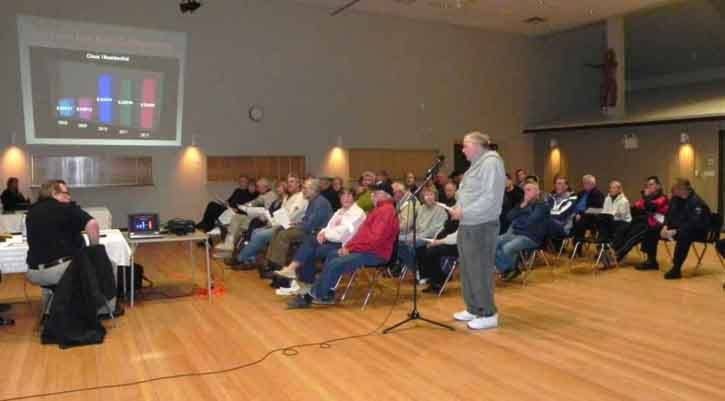The average Harrison Hot Springs resident will see a decrease in their tax bill this year, according to the Village’s Chief Financial Officer.
Dale Courtice presented an overview and highlights of the 2012 budget during a special public meeting on Tuesday night in Harrison Memorial Hall. The presentation included planned projects, tax rate comparisons and further explanation of billing changes in the Village. The budget went through three readings with a unanimous vote, and was to be adopted on Thursday night, after press time.
Aveage assessments were used to illustrate the effect the budget would have on tax payers. The average single family home in Harrison is $336,500, down about $5,300 from last year.
With a tax rate of about 3.23 per cent for a single family home, a tax bill will be about $2,211.50. That’s down about $50 from 2011’s taxes.
For strata units, the drop is even greater. With the average unit assessment of $264,300, a tax bill would be about $1,737 – a savings of about $200 over last year.
Business tax rates are somewhat higher than residential rates, at 11.31928 per cent. Class 8 properties (recreational and non-profits) are even higher at 14.5.
While 49 per cent of the money collected through tax bills goes to the Village, the rest is doled out to outside government agencies, such as the Regional District, hospital, schools, RCMP and the Assessment Authority.
Courtice used a number of different styles of graphs to illustrate just where taxpayers’ money goes every year. After several requests from the public, the Village agreed to post a downloadable copy of the presentation on their website.
Courtice outlined that residential tax payers contribute almost 57 per cent of the tax revenue to the Village ($1,007,000), while businesses pay about 40 per cent ($710,000) and Class 8 properties pay 3.2 per cent ($57,000).
But the Village doesn’t run on tax payments alone. In fact, only 18.7 per cent of its revenue comes from taxes. The 40 or so people in attendance heard about other revenue streams that help pay the bills, including development cost charges ($313,000) and governments grants ($1,896,700).
Grants include money from the Municipal Rural Infrastructure Funding, which will help pay for the completion of the upgrade of the existing Wastewater Treatment Plant. Courtice identified several projects to be focused on in the near future, with finishing the new plant at the top of the list.
The Village will also be purchasing a new fire truck, with $375,000 set aside from last year, and finishing the paving and sidewalk work on the McCombs bridges, at a cost of $60,000. There will be new lamp standards put in, at a rate of about seven each year and a cost of about $2,500 a lamp.
Courtice also explained the Resort Municipality Initiative (RMI) projects.
These were discussed briefly at Monday night`s council meeting, and explained with more detail on Tuesday. (For more information on RMI, see this story online at www.ahobserver.com.)
The Village will receive $310,000 a year for the next five years to address tourism related infrastructure projects. That money is related to the extra two per cent hotel tax collected locally. For 2012, plans include a water spray park, trail work, information signage, streetscape improvements and new garbage and recycling bins.
The Village is making an attempt to lessen their bills, and carbon footprint, by creating an inventory of their current electrical equipment. They`ll be switching to lower consumption lighting, in an attempt “to see cost savings down the road,” Courtice said.
He also explained the changes to how the Village bills for water and sewer usage. Those fees will now be sent in a separate quarterly bill, beginning around the end of April. The move was made to lighten the load of taxpayers by spreading the cost of services throughout the year.
Council and staff will continue to look for other sources of funding for the inevitable upgrades for the water filtration system and extension, which is estimated at about $1 million.
“We can’t just find $1 million and put it in,” Mayor Leo Facio said. “It’s always a waiting game for the money.”
news@ahobserver.com
